Saint of the Day
Summary: Once a spiritual director at the English College, Rome, St Robert Bellarmine encouraged the student priests there who were later to become martyrs. He was a Jesuit theologian and then a bishop who was almost elected pope. He also concurred in the condemnation of Galileo.
Patrick Duffy reiterates his story here.
Early 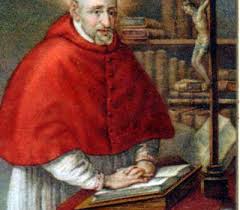 Life
Life
Born in Montepulciano in Tuscany, Robert’s father was a chief magistrate and his mother the sister of Pope Marcellus II (Marcello Cervini – 1555). After a broad education, he entered the Jesuits at 18. He taught classics and studied theology at Padua and Louvain, where he was ordained.
Theologian to Pope Clement VIII
Robert taught controversial theology – it was the Reformation time – and was recalled to teach at the Gregorian University. He was also spiritual director to the English College when many of the students would have to face martyrdom when they went back to their home country. Then after three years as Jesuit provincial in Naples, Pope Clement VIII (Ippolito Aldobrandini, pope 1592-1650) called him to be his personal theologian. Subsequently he became a cardinal and archbishop of Capua. Almost elected pope in 1605, the new pope, Paul V (Camillo Borghese), appointed him prefect of the Vatican Library.
Concurred in Galileo’s Condemnation
Although Galileo was a personal friend, Bellarmine accepted the Ptolemaic view of the earth as the centre of the universe and though he tried to persuade Galileo to present the Copernican view as theory and not as fact, he concurred in Galileo’s condemnation.
Later Life
Towards the end of his life he retired to the Jesuit novitiate in Rome and wrote a devotional work on The Art of Dying Well. He died on 17th September 1621 and is buried in the Lady Chapel of the Gesù, the main Jesuit church in Rome. He was canonised in 1930 and declared a doctor of the Church the following year.

Summary: Hildegard of Bingen, (1098–1179), a German writer, composer, philosopher, mystic, Benedictine abbess, visionary, & polymath. “Who is this woman?” asked Cistercian Pope Eugenius III, when shown her writings. “She rises out of the wilderness like a column of smoke from burning spices.”
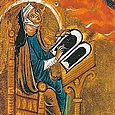 Hildegard had a big influence in her own day but was wiped out from Church consciousness for eight centuries, in recent years she has made a big comeback through feminism, and creation/ environmental theology. The central theme of her writings is the life-giving power of God – what she called “the beauty of greenness” (pulchritudo viriditatis). There is also much recent interest in her music and poetry.
Hildegard had a big influence in her own day but was wiped out from Church consciousness for eight centuries, in recent years she has made a big comeback through feminism, and creation/ environmental theology. The central theme of her writings is the life-giving power of God – what she called “the beauty of greenness” (pulchritudo viriditatis). There is also much recent interest in her music and poetry.
Patrick Duffy profiles this extraordinary medieval lady.
Childhood at Bermerstein and her formation
Born in 1098, the tenth child of noble parents Hildebert and Mechtild at Bermersheim near Mainz in the Rhineland, Hildegard was educated at the Benedictine cloister of Disibodenberg by Jutta von Spanheim and succeeded her as abbess when she died in 1136.
Visions
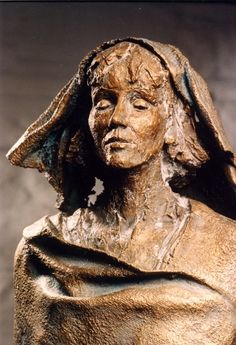 From the age of three she had experienced visions accompanied by headaches. On reporting them to her confessor, he encouraged her to write them down, and the headaches disappeared. Her confessor showed what she had written to the archbishop of Mainz, who appointed a monk named Volmar to be her secretary.
From the age of three she had experienced visions accompanied by headaches. On reporting them to her confessor, he encouraged her to write them down, and the headaches disappeared. Her confessor showed what she had written to the archbishop of Mainz, who appointed a monk named Volmar to be her secretary.
The Scivias
The archbishop showed the resulting work Scivias (short for Scito vias Domini = “Know the ways of the Lord” 1142-52) to the Cistercian Pope Eugenius III, then visiting Trier. “Who is this woman?” he asked when he read it. “She rises out of the wilderness like a column of smoke from burning spices.” The book contains 26 visions about the Church, the relationship between God and man and redemption. It is a theology, telling the history of salvation centred on Jesus from creation to the Second Coming.
Her convent at Rupertsberg
Around 1147 Hildegard – possibly to secure a more independent role for herself and her sisters – left Disibodenberg for Rupertsberg near Bingen on the Rhine. The move caused a rift with the abbot and monks of the monastery of St Disibod – because of the feared loss of revenue – and stress to Hildegard, but within a few years she had a thriving community of fifty nuns.
Knowledge of Medicine
Hildegard cared for the sick nuns of her own community and from this experience she wrote two books on medicine. It describes herbal remedies and the circulation of the blood five centuries before Harvey.
Poetry, Music and the Arts
A gifted poet and musician, she also produced hymns and canticles for her nuns to sing. These have recently been reproduced and are currently popular sales items. She also installed a piped-water system in her convent. She made illustrations for the Scivias and devised an early form of an international language like Esperanto.
Convent Under Interdict
Hildegard came into conflict with the archbishop of Mainz when she took a decision to bury in the convent cemetery the body of a young nobleman, who had been excommunicated. She knew that the man had repented before he died and she had acted in good conscience. The archbishop put her monastery under interdict thus depriving the community of the sacraments for some months and forbidding music in their church. Hildegard’s response was to write a long letter to the bishop on sacred music to which she added:
“Those therefore who, without good reason, impose silence on churches in which singing in God’s honour can be heard will not deserve to hear the glorious choirs of angels praising the Lord in heaven.”
The archbishop lifted the interdict.
When she was about sixty, she devoted five years going around actively preaching and teaching and speaking to all kinds of people.
Death and Influence
Active to the last, Hildegard died on 17 September 1179. Though many miracles were reported during her life and at her tomb, she was never formally canonised, but she is listed as a saint for that day in the Roman Martyrology.
Hildegard’s Relics
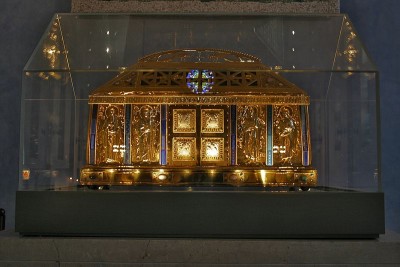
Summary: St Hildegard of Bingen, a visionary and mystic in her medieval Germany, now she is very much admired as a saint.
Fr. John Murray PP details her life
![]() St Hildegard was born a tenth child in the family and as was customary at that time this child, which the family could not count on feeding, was dedicated at birth to the Church. She was entrusted to the special care of Jutta, devout sister of a local count.
St Hildegard was born a tenth child in the family and as was customary at that time this child, which the family could not count on feeding, was dedicated at birth to the Church. She was entrusted to the special care of Jutta, devout sister of a local count.
Jutta was renowned in her own time as a very holy woman – indeed she was originally an anchoress, a unique form of religious life peculiar to the era – and when she formed a religious community, Hildegard and several other young women followed her. When Jutta later died, Hildegard was chosen as ‘magistra’ to take over the running of the community.
Benedictine Abbess
In time, Hildegard formalized her religious life by becoming a Benedictine nun; she always wanted the Church’s blessing on the direction of her own life and the lives of the sisters for whom she was responsible. She moved her convent to Rupertsberg near Bingen on the river Rhine in 1147 and as abbess founded another one at Eibingen in 1165.
A Light
 Even as a very young child Hildegard’s spiritual experiences were overwhelming; but she preferred to keep them to herself, too shy to appear boastful about them. ‘I saw a light so great that it frightened me,‘ she later wrote of a vision she experienced when she was three, ‘but the shyness of a child stopped me telling anyone about it.’
Even as a very young child Hildegard’s spiritual experiences were overwhelming; but she preferred to keep them to herself, too shy to appear boastful about them. ‘I saw a light so great that it frightened me,‘ she later wrote of a vision she experienced when she was three, ‘but the shyness of a child stopped me telling anyone about it.’
Indeed, she realized very soon that other children did not share such visions and she had the wisdom at an early age to keep her own counsel. Despite this, her early life was by and large rather uneventful, but it was during these years that she grew in mystical graces and especially in her gift of prophecy.
In later life Hildegard felt bold enough to tell her confessor of her visions and he encouraged her to write them down. This she did, combining her words on her visions with other treatises on herbal medicine, the lives of the saints and even politics. She had the gift of extremely vivid imagery. She insisted that she saw everything perfectly awake and not in some sort of trance or dream.
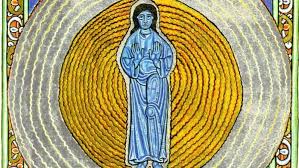 Modern medicine would probably diagnose Hildegard as suffering from migraine headaches. Some would say that the way she describes her visions and their debilitating after-effects point to the classic symptoms of migraine. However, her writings indicate the strength of character of a remarkable woman:
Modern medicine would probably diagnose Hildegard as suffering from migraine headaches. Some would say that the way she describes her visions and their debilitating after-effects point to the classic symptoms of migraine. However, her writings indicate the strength of character of a remarkable woman:
‘Finally one day I discovered I was so sick I couldn’t get out of bed. Through this illness God taught me to listen better. Then, when my good friends Richard and Volmar urged me to write, I did. I started writing this book and received the strength to finish it somehow in ten years. These visions weren’t fabricated by my own imagination nor are they anyone else’s. I saw these when I was in the heavenly places. They are God’s mysteries. These are God’s secrets. I wrote them down because a heavenly voice kept saying to me, “See and speak! Hear and write!” ‘
The 12th century was a time of schisms and religious foment, when anyone preaching some outlandish doctrine could attract a following. Hildegard was critical of schismatics. She wanted her visions approved by the Church, although she herself never doubted their divine origins.
St Bernard
She even wrote to St. Bernard seeking his blessing. His answer to her at the time was perhaps a little perfunctory. He did at least bring it to the attention of Pope Eugenius (1145/53) who encouraged Hildegard to continue her writings and to publish whatever parts she thought would be helpful to the faithful. With this papal imprimatur she was able to finish her first visionary work (Scivias – “Know the ways of the Lord”) and her fame spread through Germany and beyond.
Pope Eugenius had submitted her writings to a commission which had considered her writings authentic. Indeed, Hildegard numbered kings and emperors as well as popes and bishops among her correspondents.
Above all her other talents, Hildegard had a great gift of music and wrote many chants and hymns which have come down to us today. She described music as the means of recapturing the original joy of paradise. According to Hildegard, Adam before the Fall had a pure voice and could join the angels in singing the praises of God. Perhaps this explains why her music most often sounds akin to angelic choirs.
Hildegard wrote hymns and sequences in honour of the saints and especially Mary. Approximately eighty of her compositions have survived, which is one of the largest repertoires among mediaeval composers. She wrote in the plainchant tradition of a single vocal melodic line, a tradition common in liturgical singing of her time. Readers would do well to seek out and purchase Hildegard’s Canticles of Ecstasy or Voice of the Blood.
She died in 1179 and was one of the first people for whom the canonization process was officially applied but the process took so long that four attempts at canonization – the last in 1244 under Innocent IV – was not completed and she remained at the level of beatification. However she is regarded by many, especially in her native Germany, as a saint and her feast day is kept on 17th September.
This article first appeared in The Messenger (September 2008), a publication of the Irish Jesuits. c/f www.messenger.ie/bookshop/





















